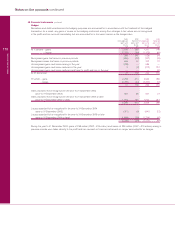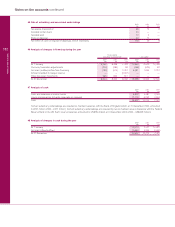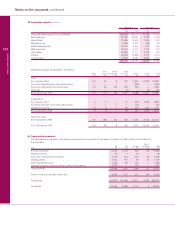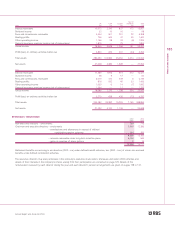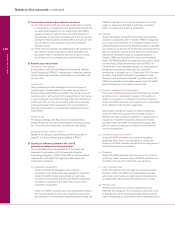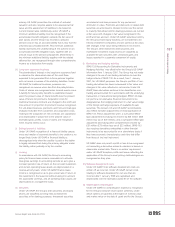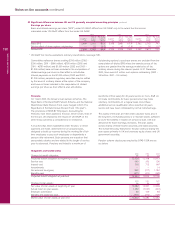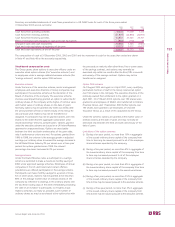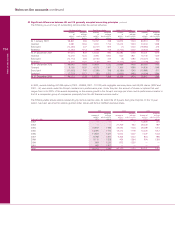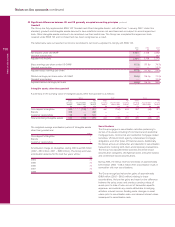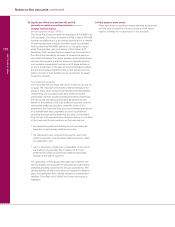RBS 2003 Annual Report Download - page 190
Download and view the complete annual report
Please find page 190 of the 2003 RBS annual report below. You can navigate through the pages in the report by either clicking on the pages listed below, or by using the keyword search tool below to find specific information within the annual report.
188
Notes on the accounts continued
Notes on the accounts
Sharesave schemes, under which employees are granted
options at a 20% discount to market value at date of grant.
Under US GAAP, the compensation is based on the
estimated fair value which is charged to the profit and loss
account over the period to their average vesting date.
(o) Variable interest entities
UK GAAP requires consolidation of entities controlled by an
enterprise where control means the enterprise’s ability to
direct the financial and operating policies of an entity with
a view to gaining economic benefits. US GAAP requires
consolidation by the primary beneficiary of a variable
interest entity (“VIE”). An enterprise is the primary
beneficiary of a VIE if it will absorb a majority of the
entity’s expected losses, receive a majority of the entity’s
expected residual returns, or both.
(p) Perpetual regulatory securities
Under UK GAAP, the Group’s perpetual regulatory
securities are classified as liabilities. Under US GAAP, they
are classified as equity instruments.
(q) Acceptances
Acceptances outstanding and the matching customers’
liabilities are not reflected in the consolidated balance
sheet, but are disclosed as memorandum items. Under US
GAAP, acceptances outstanding and the matching customers’
liabilities are reflected in the consolidated balance sheet.
(r) Offset of repurchase and reverse repurchase agreements
Under UK GAAP, debit and credit balances with the same
counterparty are aggregated into a single item where there
is a right to insist on net settlement and the debit balance
matures no later than the credit balance. Under US GAAP,
repurchase and reverse repurchase agreements with the
same counterparty may be offset only where they have the
same settlement date specified at inception.
(s) Deferred taxation
Accounting for deferred tax under UK GAAP is consistent
with US GAAP except that deferred tax is not recognised
under UK GAAP on certain timing differences resulting from
the roll-over of gains on disposal of properties, but is
provided under US GAAP on such differences.
Recent developments in US GAAP
In April 2003, the Financial Accounting Standards Board
(“FASB”) issued Statement of Financial Accounting Standards
(“SFAS”) 149 ‘Amendment of Statement 133 on Derivative
Instruments and Hedging Activities’. It amends and clarifies
accounting for derivative instruments, including certain
derivative instruments embedded in other contracts, and
hedging activities under SFAS 133. The statement is effective
for contracts entered into or modified after 30 June 2003, and
for hedging relationships designated after 30 June 2003.
Implementation of SFAS 149 has had no effect on the Group’s
US financial information.
The FASB issued SFAS 150 ‘Accounting for Certain Financial
Instruments with Characteristics of both Liabilities and Equity’
in May 2003. This statement addresses classification and
measurement by an issuer of certain financial instruments with
characteristics of both liabilities and equity. SFAS 150 also
addresses the classification of certain financial instruments
that embody obligations to issue equity shares. The statement
is effective for financial instruments entered into or modified
after 31 May 2003 and is otherwise effective on or after 15
June 2003. SFAS 150 has not affected the classification of any
of the capital instruments issued by the Group.
The FASB issued SFAS 132 (revised) ‘Employers’ Disclosures
about Pensions and Other Postretirement Benefits – an
amendment of FASB Statements No. 87, 88 and 106’ in
December 2003. This statement retains the disclosures
required by SFAS 132 and requires additional information on
changes in pension and other post-retirement benefit
obligations and fair value of assets. SFAS 132R is effective for
the Group’s 2003 financial statements.
In December 2003, the FASB issued FASB Interpretation
(“FIN”) No. 46 (revised) ‘Consolidation of Variable Interest
Entities, an interpretation of ARB No. 51.’ FIN 46R clarifies
some of the provisions of FIN 46, issued in January 2003, and
exempts certain entities from its requirements. FIN 46R
replaces FIN 46 but as FIN 46R contains deferral provisions,
FIN 46 is extant until FIN 46R is applied. FIN 46 and FIN 46R
address accounting for VIEs. Expected losses and expected
residual returns of a VIE have been clarified in FIN 46R as the
expected negative variability and positive variability,
respectively, in the fair value of its net assets excluding
variable interests and include expected variability resulting
from the operating results of the entity.
The Group elected to adopt the provisions of FIN 46R as at 31
December 2003, except in relation to certain investments made
by its private equity business which is involved with entities that
may be deemed to be VIEs. The FASB has deferred non-
registered investment companies (entities that invest for capital
appreciation and income) from the application of FIN 46R until
the scope of investment company accounting has been
clarified by the American Institute of Certified Public
Accountants.
The FASB continues to provide additional guidance on
implementation of FIN 46. As further guidance is provided, the
Group will continue to review the status of the VIEs with which
it is involved.
53 Significant differences between UK and US
generally accepted accounting principles (continued)


